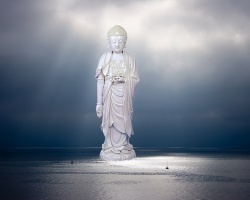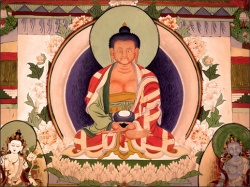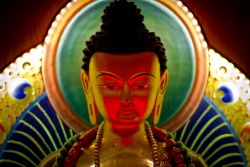The Eightfold Path
eight-fold path (marga): the fourth of the four noble truths, practices taught by the buddha for those entering the path to nirvana:
wisdom (prajna)—
1) right view (samyag-drsti),
2) right intention or resolve (samyak-samkalpa); morality (sila)—
3) right speech (samyag-vac),
4) right action (samyak-karmanta),
5) right livelihood (samyag-ajiva); concentation (samadhi)—
6) right effort (samyak-vyayama),
7) right mindfullness (samyak-smrti),
8) right meditation (samyak-samadhi).
this is path is not a linear one, but one in which all of the eight factors are practiced simultaneously. it was later taught as the three principle practices or trainings of “morality, concentration, and wisdom.” part of the thirty-seven branches or factors of enlightenment.
The Eightfold Path, although referred to as steps on a path, is not meant as a sequential learning process, but as eight aspects of life, all of which are to be integrated in every day life. Thus the environment is created to move closer to the Buddhist path.
The Eightfold Path is at the heart of the Middle Way, which turns from extremes, and encourages us to seek the simple approach.
The Eightfold Path is Right Understanding, Right Intent, Right Speech, Right Action, Right Livelihood, Right Effort, Right Mindfulness, and Right Concentration.
No doubt all of you are aware of the moral codes in other religious groups such as [[Wikipedia:Christianity|Christianity]], the Jews, and Muslims. While there is a degree of correspondence across these groups, the interpretation of the code in each philosophy is different. In the example of the Ten Commandments, there is an authoritarian feeling of decree, of a direct order that these be fulfilled.
In Buddhism, the Eightfold Path is meant as a guideline, to be considered, to be contemplated, and to be taken on when, and only when each step is fully accepted as part of the life you seek. Buddhism never asks for blind faith, it seeks to promote learning and a process of self-discovery.
The meaning of Right has several aspects, and includes an ethical, and a balanced, or Middle Way. When things go "right", we often experience a special feeling inside which confirms that this is the correct decision or action.
Right Understanding:
The first step of the Eightfold Path is Right Understanding or Right View.
This is a significant step on the path as it relates to seeing the world and everything in it as it really is, not as we believe it to be or want it to be. Just as you may read the directions on a map, and then make the journey, studying, reading and examining the information is important, but only the preparation for the journey. At a deeper level, direct personal experience will then lead us to Right Understanding.
Thich Nhat Hanh tells the story of The Buddha. The Buddha says "my teaching is not a dogma or a doctrine, but no doubt some people will take it as such." The Buddha goes on to say "I must state clearly that my teaching is a method to experience reality and not reality itself, just as a finger pointing at the moon is not the moon itself. A thinking person makes use of the finger to see the moon. A person who only looks at the finger and mistakes it for the moon will never see the real moon."
Knowing reality is of very little value if we don’t put it to personal use in our lives.
Right Intent:
The second step on the Eightfold Path is Right Intent. This is the step where we become committed to the path. Right Understanding shows us what life really is and what life’s problems are composed of, Right Intent urges us to decide what our heart wants.
Right Intent must come from the heart and involves recognising the equality of all life and compassion for all that life, beginning with yourself.
Right Intent means persistence and a passion for the journey. Setting out to climb a high mountain means you must understand the lay of the land and the pitfalls, the other team members, and the equipment you need. This is similar to Right Understanding. But you will only climb the mountain if you really want to and have a passion for the climb. This is Right Intent. The mountain we climb here is our journey though life.
To summarise, Right Understanding will eliminate ignorance. With Right Intent and correct understanding, we then remove desire, which in turn causes the Suffering defined in the Four Noble Truths.
Right Speech:
Right Speech is the next step of the Path. We tend to underestimate the Power of the spoken word, and often regret words said in haste. Each of us has experienced the disappointment associated with harsh criticism, whether justified or not, and we also are likely to have felt good when kind words encouraged us.
Right speech involves recognition of the truth, and also an awareness of the impact of idle gossip and of repeating rumours. Communicating thoughtfully helps to unite others, and can heal dissention. By resolving never to speak unkindly, or in anger, a spirit of consideration evolves which moves us closer to everyday compassionate living.
Right Action:
Right Action recognises the need to take the ethical approach in life, to consider others and the world we live in. This includes not taking what is not given to us, and having respect for the agreements we make both in our private and business lives.
Right Action also encompasses the Five Precepts which were given by The Buddha, not to kill, steal, lie, to avoid sexual misconduct, and not to take drugs or other intoxicants.
This step on the path also includes a whole approach to the environment, with Right Action being taken whenever possible to safeguard the world for future generations.
Right Livelihood:
The next on the Eightfold Path follows on from Right Action, and this is Right Livelihood. If your work has a lack of respect for life, then it will be a barrier to progress on the spiritual path. Buddhism promotes the principle of equality of all living beings and respect for all life.
Certain types of work were discouraged by The Buddha, in particular those where you deal in harmful drugs and intoxicants, those dealing in weapons, and those harmful to animal or human life. So a dedicated Buddhist would not be recommended to have a liquor store, own a gun shop, or be a butcher. In his time, he also discouraged the slave trade, which dealt in human workers. And he was also against the practice of fortune telling as this made assumptions about a fixed future, where his teaching stresses that the future is created by what we do today.
Right Livelihood also implies that a Buddhist who is able, will undertake some work, either as part of a Buddhist community, or in the workplace, or, alternatively, do home based or community service. Many communities of monks ensure that each member has daily chores, which remind him of this step on the Eightfold Path.
Right Effort:
Right Effort means cultivating an enthusiasm, a positive attitude in a balanced way. Like the strings of a musical instrument, the amount of effort should not be too tense or too impatient, as well as not too slack or too laid back. Right Effort should produce an attitude of steady and cheerful determination.
In order to produce Right Effort, clear and honest thoughts should be welcomed, and feelings of jealousy and anger left behind. Right Effort equates to positive thinking, followed by focused action.
The Buddha was well ahead of his time on this one, and many books have been written about the Power of the right attitude.
Right Mindfulness:
While Right Effort is a very easy concept for most of us, Right Mindfulness is somewhat trickier to grasp, and may involve quite a change of thinking.
I suggest that you take a short break, stand up and walk (or cruise if you are mobile) around the room or house, and then come back here before reading on.
Right Mindfulness means being aware of the moment, and being focused in that moment. When we travel somewhere, we are hearing noises, seeing buildings, trees, advertising, feeling the movement, thinking of those we left behind, thinking of our destination. So it is with most moments of our lives.
Right Mindfulness asks us to be aware of the journey at that moment, and to be clear and undistracted at that moment. Right Mindfulness is closely linked with meditation and forms the basis of meditation.
Right Mindfulness is not an attempt to exclude the world, in fact, the opposite. Right Mindfulness asks us to be aware of the moment, and of our actions at that moment. By being aware, we are able to see how old patterns and habits control us. In this awareness, we may see how fears of possible futures limit our present actions.
Now, having read this, try the same walk as before but with a focused mind, which now concentrates only on the action of the walking. Observe your thoughts before reading on.
Sometimes you may be absorbed in what you are doing. Music, art, sport can trigger these moments. Have you ever done anything where your mind is only with that activity. At that moment, you are mindful, and The Buddha showed how to integrate that awareness into our everyday lives.
Right Concentration:
Once the mind is uncluttered, it may then be concentrated to achieve whatever is desired. Right Concentration is turning the mind to focus on an object, such as a flower, or a lit candle, or a concept such as loving compassion. This forms the next part of the meditation process.
Right concentration implies that we select worthy directions for the concentration of the mind, although everything in nature, beautiful and ugly, may be useful for concentration. At deeper levels, no object or concept may be necessary for further development.
The benefits of Right Mindfulness and Right Concentration are significant as they teach the mind to see things, not as we are conditioned to seeing them, but as they really are. At the same time, they also lead to a feeling of calm and peace with the world. By being in the moment and being able to concentrate effectively, a sense of joy is the moment is felt. Release from the control of past pains and future mind games takes us closer to freedom from Suffering.





